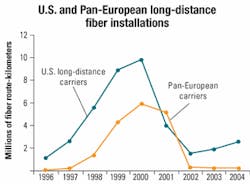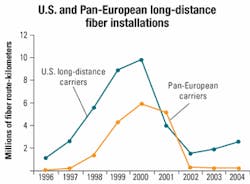After the fall
BY PATRICK J. FAY
An analysis of the 2001 downturn in fiber-optic cable demand doesn't forecast good news this year.
The worldwide market for optical-fiber cable experienced a rapid downturn in mid-2001. Following 48% year-on-year growth from 1999 to 2000 in the amount of cabled fiber installed worldwide, installments dropped by 10% in 2001. Two main factors are responsible:
- Most major carriers completed the build-out of their networks, and not enough new projects among a group of "emerging carriers" were funded to sustain demand.
- Weakness in the economy and especially in the financial performance of major companies in the telecommunications sector curtailed the flow of investor money.
The first item represents a saturation of fiber in the networks of new backbone operators. A major component of this fiber-demand growth in 1999 and 2000 was deployment in new long-distance networks, especially in North America and Western Europe. In the United States, for example, there were 36 long-distance carriers with fiber-based networks in 1996, and by 2001, this number had increased to 69. And of more importance for fiber demand, the number of these carriers that had built nationwide networks as opposed to regional or statewide networks increased significantly from 1996 to 2001.
This build-out of new long-distance networks in the United States represented a huge demand for fiber. U.S. long-distance carriers increased their installments from 1.1 million fiber-km in 1996 to 9.8 million fiber-km in 2000. As these networks were completed in 2000 and 2001, demand for fiber among these carriers dropped precipitously. Long-distance carriers installed 4 million fiber-km in 2001, accounting for nearly a 6-million-fiber-km decrease in demand from 2000 to 2001.
A similar build-out has taken place in Western Europe, where the number of pan-European carriers rose from four in 1997 to 26 in 2001. The pan-European carriers as a group installed 16.6 million fiber-km from 1998 through 2001. In 2000, these carriers installed 5.9 million fiber-km, and in 2001, the annual installations are expected to have come in at 5.1 million fiber-km. This annual demand, however, will fall to 255,000 fiber-km in 2002. Together, U.S. and pan-European long-distance operators accounted for about 15 million fiber-km installed in 2000, and this demand has disappeared (see Figure).
KMI views the fiber-demand growth in the late 1990s as driven by four main factors: deregulation, Internet bandwidth, investor money, and new technology.
Deregulation refers to the changes many national governments had made to move beyond the earlier era of monopoly or government-owned telecommunications enterprises. These changes essentially allow new carriers to enter domestic and international telecom markets using "own-built" fiber networks or capacity that has been leased, swapped, or obtained through indefeasible rights-of-use contracts.
If deregulation provided the legal or regulatory opportunity for new carriers, it was Internet bandwidth that provided the business case in the late '90s. As Internet bandwidth demand exploded, it was thought new carriers could profitably serve Internet service providers with new services. This promising opportunity attracted the financial markets. New telecom networks provided an attractive investment sector for both debt and equity placements. During the late '90s, the manufacturing community also benefited from high market capitalizations and a high-volume flow of investor money. As a result, some carriers found themselves having to overlay older networks with the latest types of fiber, so they could take advantage of new and efficient transmission technology and remain competitive with emerging carriers.
Essentially, deregulation was a "one-time" growth factor in the '90s. The countries that are not far along with this process are generally not large contributors to fiber demand.
Internet bandwidth may continue to drive the demand for new fiber but will not translate as easily as before into network construction. First, bandwidth forecasts range from about 50% per year to hundreds of percent per year. Second, the number of wavelength channels in DWDM systems has been doubling every year for the past four or five years. This trend is not expected to continue indefinitely, but there are bands in the fiber that have not been fully exploited, and many companies are working on new filter and laser technologies.The TDM bit rate of a single-wavelength channel has been quadrupling about every six years as well. The early phases of a jump from 10 Gbits/sec to 40 Gbits/sec are in place, and there is laboratory work on higher rates. Conservative assumptions for progress in TDM and WDM rates can result in the bandwidth capacity of a fiber increasing with a CAGR of 50-70% per year for the foreseeable future. Bandwidth demand must continue to exceed this rate to remain a sustainable driver for new fiber.
The third factor in the recent growth, investor capital, has most directly contributed to the current volatility in the fiber market. Investors funded too many new networks too quickly, and now the market is in the midst of a correction. The final factor, new technology, will continue to contribute to growth in fiber demand. New generations of fiber will be developed and introduced to support 40-Gbit/sec transmission. Some carriers will need to overlay their older networks to take advantage of these technologies. But with fewer carriers in the market, that is likely to be less of a driver.
Based on these factors, KMI does not see fiber demand returning to 2000 levels until 2004. Growth in demand will slow from a 30% CAGR from 1990 to 2000 to a 9% CAGR from 2001 to 2006.
Patrick J. Fay is an analyst at KMI Corp. (Providence). He directs market research on worldwide optical fiber, fiber-optic markets, and splice closures and maintains KMI's FiberGlobe database, which includes fiber-optic installation information for over 50 countries worldwide.

